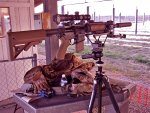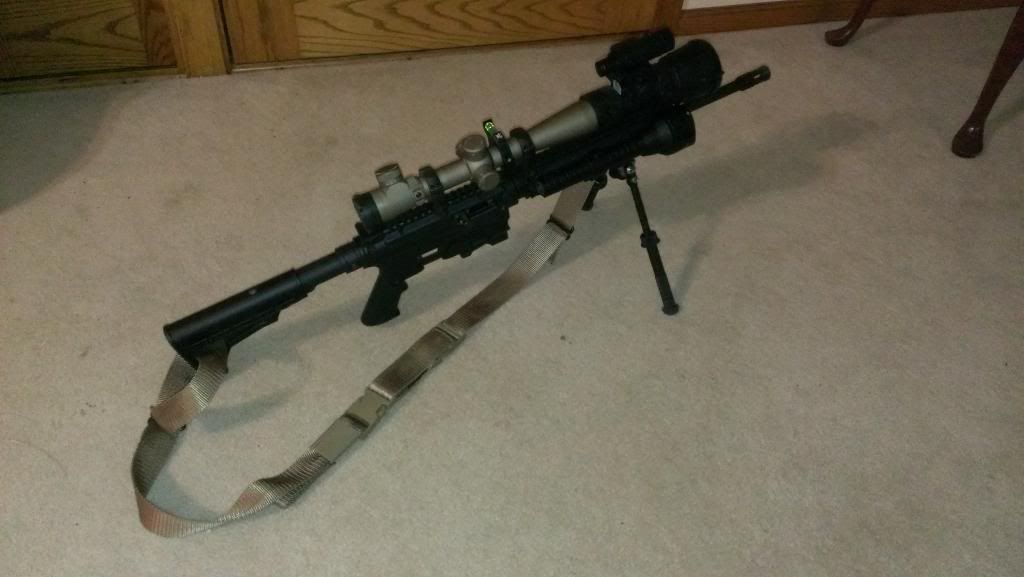Interesting how the OP asked for input on learning to shoot precision out to 600yds, and half the responses are telling him to get a bolt gun, different barrel length, equipment, equipment, equipment, after he already has selected a perfectly capable set of components for shooting out to 600yds.
If I could go back in time to myself and give myself some advice, I would send myself to a series of formal training courses from competent, experienced, and reputable instructors. Thankfully, I did receive a lot of that from 1st SFG's SOTIC back when I was very young, and fell in love with the wind-reading skill set after I realized how critical it is with a cartridge like 7.62 M118 Special Ball. Someone already mentioned Rifles Only, which is very sound advice. You will be in some of the best hands in the Nation with them. I would also recommend getting out and competing, regardless of skill level. You can only get better.
The biggest leap in your learning curve is going to be getting practical exercise on wind-reading from someone that has been shooting in the wind regularly for years. You can watch all the videos, read all the books, and run your ballistics through a program until your eyes bulge out, but nothing will make up for getting behind a scope and watching bullets travel through dynamic wind, temperature, and barometric environments that are not the same hour-to-hour.
We frequently shoot well-built 16" 5.56 or .223 Wylde carbines out to 600yds with 68gr Hornady HPBT, 69gr SMK, 75gr HPBT, and 77gr HPBT, on 18" plates. If all you are going to do is lay in the prone bipod supported, or ride a bench at the range, then go with as long of a barrel as possible without over-doing the dwell time, and look at other calibers than .223 Remington, unless you are ok with single-loading 80gr and 90gr SMK's & VLD's.
But if you're like me, and want to be able to go from a walking, smoking & joking posture, to behind cover and placing effective fire on man-sized targets from difficult positions out to the effective range of your carbine within seconds, the 16" guns are the way to go, unless you are a beast of a man at well over 6ft 2"/250lbs. When you start shooting positions, the lighter, handier gun is faster on-target, easier to sling into, easier to hold on-target, and just easier to manage all around. If your 18" SPR clone with bipod and quad rail is doing the figure 8 in a kneeling position, while I impact steel with a little 16" MLGS blaster with a quality barrel, which one is better?
18" vs. 16" External Ballistics
Run the external ballistics on a 77gr SMK fired from an 18" vs. a 16" and see how relatively meaningless it is. 600yds is hard to hit from positions with either gun, and from all the shooters I have seen over the years, 400-450yds is where most people max out with positional shooting on 18" plates in ~10mph full value winds. Anybody who can hit 18" plates from improvised kneeling or seated positions on the fly consistently past 450yds is an exceptional shooter (not with a dedicated shooting vest and tricked gear specifically for that position-you aren't going to walk around in a shooting jacket and eye blinders with your loop sling set-up already).
As to bolt guns, they are practically worthless in a react-to-contact scenario if facing somebody with a self-loader, especially with heavy barrels. Gifted shooters can do amazing things with a well-built bolt gun, especially with a shorter barrel, but the advantage will be to the self-loader for practical shooting. If I'm just consuming oxygen at the range from a comfortable bench, with my growing middle-aged plumber butt offending passers by, yeah, a bolt gun is hard to beat, and you can really drive yourself into a false sense of assumed practical capability by drilling sub-MOA groups "all day long", before you pack up your fire stick and head back home to gloat on your marksmanship skills.
Take incoming fire from afar, with limited cover available, with your stick of choice, and now find a position that will be the solution to your survival. That is what I'm more interested in. Is the means matching the end? That is the question I always ask myself. If my only goal is to enjoy my rifle and pursue the most accurate loads with it as a discipline, then there's nothing wrong with that, but I always have looked at firearms as martial tools meant for distributing violence at as comfortable of a distance as the situation will allow, so I configure and treat them accordingly. Range guns are basically useless to me, for my personal tastes.
Components
For some advice on components, please consider getting a stock that will support a natural cheek weld, which the UBR just doesn't do for a lot of people. I would suggest a simple and inexpensive CTR with the QD sockets, and get a low-profile scope level. For the MOE grip, get the MOE+ if you are set on that design. It is wrapped in elastomer, and feels much better than a regular MOE.
Get an upper receiver that has a square face, or consider an VLTOR MUR upper. The Aero Precision uppers that I have checked have all had pretty square faces so far, and they were very affordable. Your gun will have a hard time grouping if the receiver face isn't square, and you will have undue load on your bolt lugs.
Ammunition
As to ammunition, the Hornady 75gr BTHP is hard to beat for box ammo, and the military 77gr Mk.262 Mod 1 from Black Hills is downright scary accurate in a lot of guns, while being very fast. FGMM is also very popular. Don't pull the trigger on your barrel unless it is MLGS with a 16" gun meant to push the heavies. 1/8 twist is perfect for up to 77gr.
Everything else on your list looks really good, except you are missing a good sling and QD swivels. The Parallax Tactical handguard has 4 integral rotation limited QD sockets, which is excellent, but I would find out what the weight is on it if you are looking for lightweight blaster. You can also order it Cerakoted in FDE, as you can with the Aero Precision upper receivers. You can also get Aero lowers Cerakoted directly from Aero to your FFL, for prices lower than a lot of plane jane receivers currently on the market.
So here's the list:
* Ditch the UBR for a CTR or VLTOR, SOPMOD Gen II, anything lighter with QD sockets and good cheek weld
* Get a Scope level, folding or lo-profile so the gun isn't a catch-me, spank me in close quarters, but is still able to be leveled when you shoot at distance
* Look into a set of Aero Precision receivers that are already FDE Cerakoted
* You need a charge handle. I recommend the BCM GunFighter w/medium latch. If you're a lefty, consider the Raptor.
* You need a buffer. Get an H or H2, and a quality recoil spring that will last if you are going to actually shoot this thing.
* Get some QD swivels and a Viking Tactics Padded sling, and learn how to set it up so that it is useful as a shooting sling.
* Start buying a crapload of 5.56 and .223 Match ammunition from Black Hills, Hornady, and Federal. It will be ~ $1/round.
* Check the optics section here on the Hide and look into how to install your mount and optic, with a plum line, correct eye relief, and leveling of the gun, optic, and level. You're going to need some Blue Loc-tite for your rings, and a torque driver to install your fasteners at 15-20 inch pounds.
* Once your balster is together and zero fine-tuned, enroll in a reputable rifle course that will teach fundamentals, wind-reading, trajectory with a lot of trigger time and minimal BS time in the classroom.




